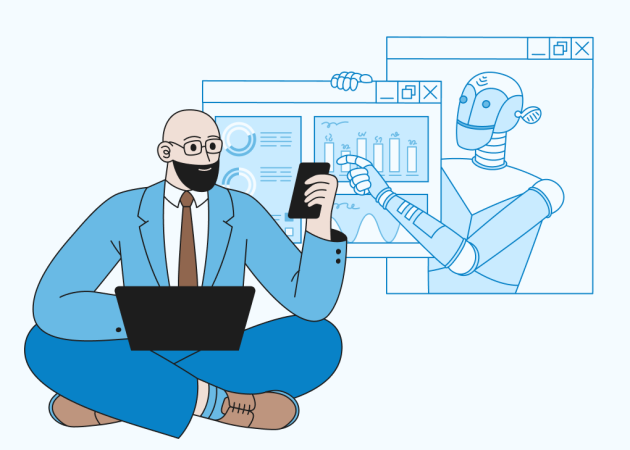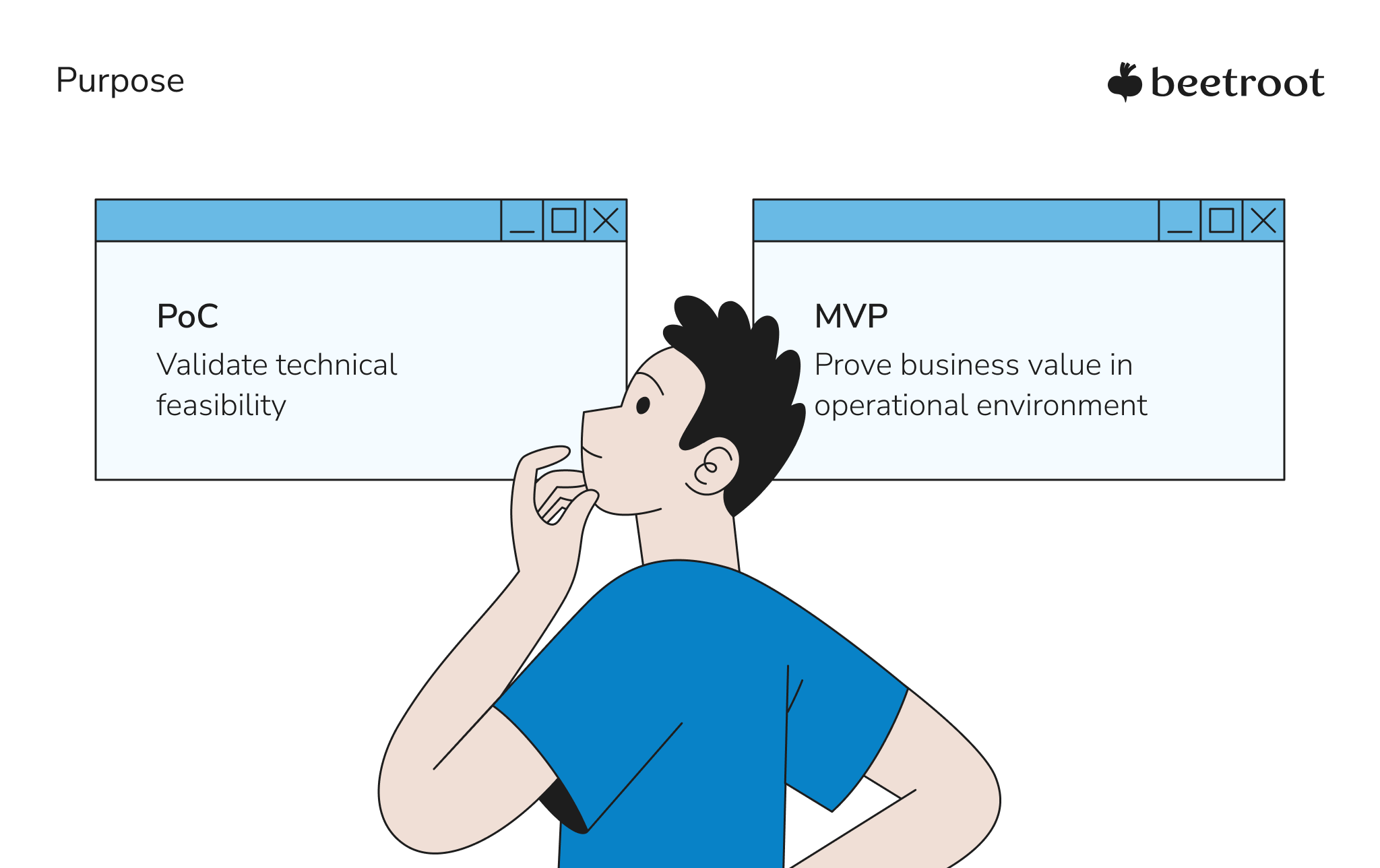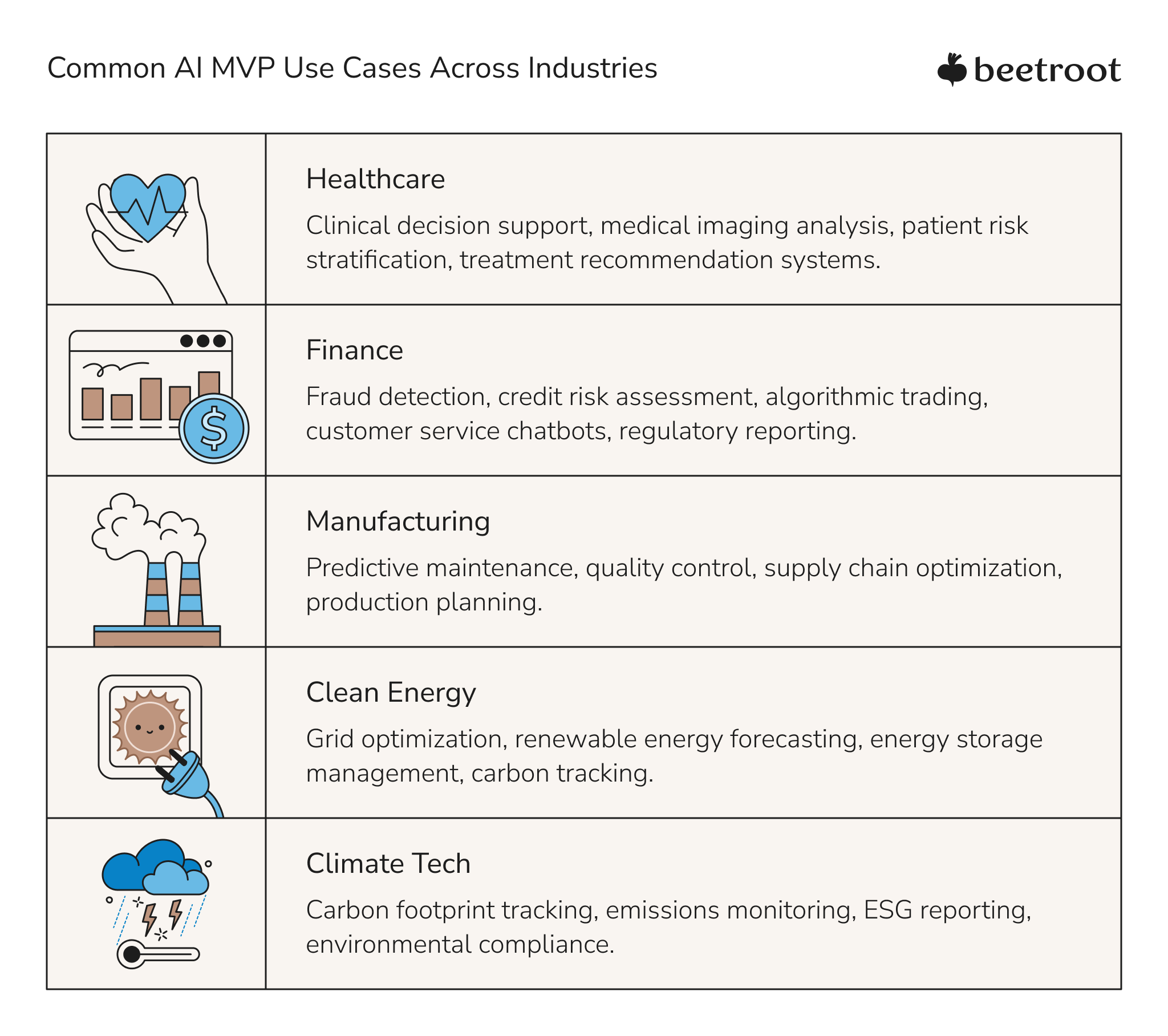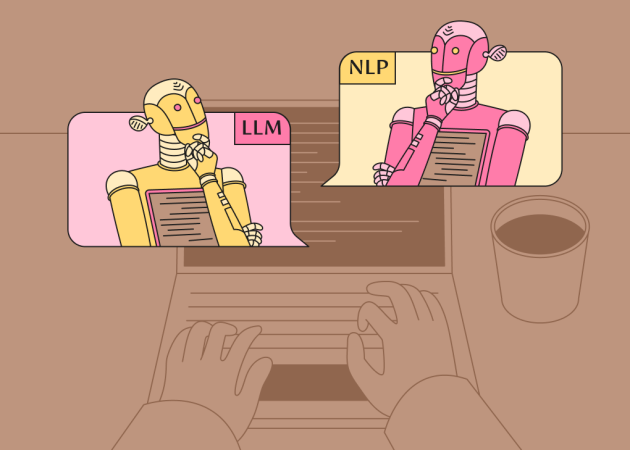
Enterprise Guide to Scoping AI MVPs: Balancing Risk, Cost & Speed
Contents
Contents
Modern enterprises face an intricate challenge: the pressure to innovate with AI and the complexity of doing so. In this context, a minimum viable product (MVP) acts as a useful link between AI strategies and practical implementation. It offers a way to validate assumptions and build organizational confidence before dedicating major resources.
Large enterprises operate with established infrastructure, strict compliance requirements, and complex stakeholder interests. Therefore, the startup approach to building an MVP, with its focus on speed above all else, is often not a viable model. This guide will help you develop an MVP that actually works in the enterprise environment — projects that deliver tangible value and help you tackle the risks and complexities that come with organizational scale.
Rethinking AI Minimum Viable Product Software in the Enterprise Context
Enterprises can spend extensive time on AI roadmap planning, architectural blueprints, and long-term visions. But when it comes to actually building and implementing, especially with something as volatile as AI, the execution can hit a wall at the scoping phase. The sheer scale and interconnectedness of enterprise systems can make it difficult to find a starting point.
That’s why learning how to create a minimum viable product is so important. MVPs offer a way to dip your toes in the water before diving headfirst. A well-scoped MVP allows you to:
- De-risk big bets. It provides a convenient way to validate your core assumptions before investing significant AI development costs.
- Generate real-world evidence. Move beyond theoretical ROI on a PowerPoint slide to actual data showing what works and what doesn’t.
- Secure buy-in. A successful pilot is the most powerful tool for aligning leadership, IT, and business units. It turns skeptics into champions.
- Achieve a quick, tangible win. In a world of long project cycles, an MVP can deliver measurable results in months, not years, boosting team morale and confidence.
Your MVP may have a minimal number of features, but it still needs to meet security standards, integrate with existing systems, and comply with relevant regulations. It goes without saying that it should also work within established workflows rather than disrupting everything.
The key is understanding that “minimum” doesn’t mean cutting corners on enterprise requirements — it means being focused on the core value proposition and maintaining the operational standards your organization demands.

Enterprise-Specific Challenges in AI MVP Development
The challenges enterprises face when developing an MVP often go beyond technical complexity. They’re often organizational and operational in nature.
Data complexity tops the list. Startups might work with clean, purpose-built datasets. Enterprises deal with decades of accumulated data across multiple systems, in various formats, with different quality levels. Your MVP needs to work with this reality, not wait for perfect data that may never come.
Stakeholder alignment is another challenge. In a large company, your AI MVP may need approval from IT, legal, compliance, operations, and various business units. Each group has its own priorities, timelines, and success metrics. Careful coordination is needed to balance different interests and keep progress on track.
Integration requirements can’t be ignored. Your MVP doesn’t exist in isolation — it needs to work with existing CRM systems, ERP platforms, security protocols, and user workflows. What seems like a simple AI application can become complex when it needs to authenticate users through Active Directory, log activities for compliance, and integrate with legacy APIs that weren’t designed for modern applications.
These enterprise challenges aren’t insurmountable, but they do require a different approach in comparison to that of startup MVP development. For example, you can address data complexity by starting with “good enough” data rather than waiting for perfection, and build data quality improvements into your MVP roadmap. Manage risk through phased rollouts, thorough testing, and clear rollback procedures. Finally, you can treat compliance as a design constraint from day one, not an afterthought. It implies building privacy, security, and auditability into your core architecture from the onset.
Defining Scope: From Strategy to a Practical AI MVP Application
The transition from AI strategy to MVP scope is where many enterprise initiatives lose their way. The key point is that MVP scoping requires being specific about what you’ll build, how it will work, and what success looks like.
Requirements gathering in large-scale organizations has its distinct nuances. You’re not just gathering requirements from users — you’re gathering them from multiple departments with different workflows, various systems that need integration, and stakeholders with competing priorities. This process needs to be systematic but not bureaucratic, comprehensive but not overwhelming.
To ease this process, you can start with the business problem, not the AI solution. What specific pain point are you trying to solve? Who experiences this pain point most acutely? What would success look like for them? These questions help ground your MVP in real user needs rather than technological possibilities.
Aligning MVP scope with enterprise strategy requires careful consideration. Your MVP should be an integral part of broader strategic goals. At the same time, it needs to be specific and achievable enough to deliver value on its own. Think of it as a building block that stands independently, but still contributes to a bigger structure of your business.
Deciding what to include in the MVP becomes a balancing act between business-critical functionality and technical feasibility. You might want to cover everything that seems important, but this can lead to unwieldy projects that take months to deliver. Instead, you can focus on the core workflow or decision that your AI will support. What’s the smallest version that would genuinely help users and demonstrate clear value?
The scope should also account for the operational reality of deployment. How will users access the AI? What training do they need? How will you monitor performance? What happens when something goes wrong? These operational considerations are integral to MVP success in enterprise environments.

It’s important to note that your AI MVP is all about creating a complete experience that fits into how your organization actually works. The goal is to scope an MVP that’s ambitious enough to demonstrate real value but does not require extensive development time. It should build organizational confidence in AI and provide a foundation for more complex applications down the road. Get this balance right, and your MVP becomes a catalyst for broader AI adoption.
How to Build an MVP While Balancing Risk, Cost & Speed
For an enterprise, an AI MVP is a balancing act. You’re managing a portfolio of risks — technical, financial, and organizational. It is crucial to find the middle ground and balance cost vs speed trade-offs.
An enterprise needs a structured approach to this. Speed cannot come at the cost of security. Cost savings cannot compromise compliance. Risk mitigation strategies cannot stifle innovation. This requires a mindset that is focused on incremental progress and measurable results.
From a business analysis perspective, the most successful AI MVPs are the ones that keep their focus razor sharp. We’re not trying to boil the ocean. We’re trying to prove one thing: that by solving this specific, high-value problem for this specific group of users, we can create a measurable impact. The scope is defined not by what the technology can do, but by what the business needs it to do, right now.
– shares Natalia Kazachiner, our Business Analyst.
How to Create an MVP in the Enterprise Context
An enterprise AI MVP requires a structured approach that balances business objectives with technical realities. Here’s a step-by-step framework designed specifically for large organizations.
Step 1
Problem Definition and Stakeholder Alignment. Define the business problem you’re solving. Gather key stakeholders early. You will likely need to include business users, IT teams, data owners, as well as compliance and security specialists. Document their requirements, constraints, and success metrics. This alignment phase often takes longer in enterprises, but it prevents costly pivots later.
Step 2
Data Assessment and Preparation. It is crucial to analyze the baseline of your project. Consider answering these questions: What data do you have access to? What quality issues exist? What governance requirements will be relevant?
Step 3
Technical Architecture Planning. Design your MVP with production in mind, even if you’re starting small. Plan for security, scalability, and integration. This might imply using cloud platforms that can scale, implementing proper authentication, and ensuring your architecture can change without complete rebuilds.
Step 4
MVP Scope Definition. Define exactly what your MVP will and won’t do. Focus on one primary workflow or decision process. Be specific about inputs, outputs, and user interactions. Document assumptions you’re making and how you’ll validate them.
Step 5
Development and MVP Testing. Build with enterprise standards from the start. This includes code review processes, testing protocols, security scans, and documentation. Your MVP might consist of only essential features, but it shouldn’t compromise on operational requirements.
Step 6
Pilot Deployment and Validation. Deploy to a controlled group of users with clear success metrics. Gather feedback not just on functionality but on usability, integration, and business impact. Plan for multiple iteration cycles based on real user experience.
Proof of Concept vs. Enterprise MVP
Many organizations confuse proof of concepts (POCs) with MVPs, but they serve different purposes. Let’s take a closer look at the crucial differences between these two:
- An AI Proof of Concept (PoC) is a small-scale experiment designed to answer a single technical question: Can this be done at all? For example, “Can we train a model to accurately pinpoint defects in our product images with 90% accuracy using this dataset?” A PoC often lives and dies in a lab environment.
- An Enterprise AI MVP answers a business question: Should we do this? It takes a technically proven concept and integrates it into a real business process to see if it delivers value. An MVP is a live, albeit minimal, product used by real people to do real work.
Here’s a closer look at the distinction:
| PoC | MVP | |
| Purpose | Validate technical feasibility | Prove business value in operational environment |
| Data Source | Sample/synthetic data | Real production data |
| Users | Technical team/researchers | Real end users |
| Security | Minimal/bypass requirements | Full enterprise security compliance |
| Next Steps | Decide whether to build an MVP | Scale to full production system |
POCs can be abandoned without consequence. MVPs are designed to evolve into production systems. This fundamental difference affects every decision from architecture to user experience.

As our Chief Delivery Officer notes,
One miscalculation enterprises make is treating AI MVPs like technical experiments. They’re business experiments that happen to use AI. The technology should be invisible to users — they should just experience better outcomes in their daily work. When we focus on smooth integration rather than impressive algorithms, we see much higher adoption rates and clearer ROI in AI projects.
Mykyta Tkachov, CDO at Beetroot
Best Practices & Case Insights for Enterprises
Real-world enterprise AI MVP success comes from understanding industry-specific challenges and learning from others’ experiences. Let’s examine how different sectors approach AI MVPs and what lessons emerge.

How It Works In Practice
Here’s a brief sketch of our AI-related expertise:
Hydrogen Pro
Hydrogen Pro, a leading ClimateTech company, wanted to create a centralized equipment tracking system to monitor equipment and validate production processes. Without proper documentation and data analysis capabilities, their manufacturing teams were essentially operating “blindfolded.”
We developed a custom-built Django-based production data system to turn things around. The solution featured an AI-powered engine for automated traceability that connects documentation directly to production processes, storing certifications for all raw materials to guarantee quality and compliance. The project resulted in high customer satisfaction, streamlined operations with full traceability capabilities, and established an ongoing maintenance partnership.
BranchPattern
Our collaboration with BranchPattern, a North American sustainability consultancy, shows how a well-executed MVP strategy can deliver measurable business impact. The project challenged us to replace multiple fragmented processes with an integrated digital platform.
The 12-week discovery phase, followed by targeted MVP development, resulted in a platform that project managers could use to see all projects and documentation in one place. The success metrics validated our MVP methodology. Our client achieved increased project efficiency among project managers and started working with a solution that brings value to existing clients.
Industry Data and Trends
Ultimately, the key takeaway is that current enterprise AI adoption reflects both opportunity and challenge. By 2026, more than 80% of enterprises are expected to have utilized generative AI APIs or models, according to Gartner research. However, by the end of 2025, at least 30% of generative AI projects will be abandoned following their PoC stage.
To succeed, companies will need to overcome common challenges like poor data quality, escalating costs, and a lack of clear business value. Technical capability isn’t the primary barrier to AI success in enterprises. Organizational readiness, process integration, and change management can determine long-term outcomes of AI adoption.
Scaling Beyond the MVP
A successful MVP is just the starting point. The next step is all about moving from a pilot to a fully-fledged, enterprise-grade production system. Below, you can find several essential steps for that matter:
- Plan for Scale from Day One. While the MVP is minimal, the architecture should still be in the spotlight. Build it on a cloud-first, modular platform (like Azure, AWS, or GCP) that can scale. This allows you to add users, data, and features without having to re-engineer the entire solution.
- Establish Feedback Loops. Production is not static. You need a process for model monitoring to detect performance degradation or data drift. Establish transparent governance for retraining models with new data to maintain their accuracy and relevance.
- Prioritize Governance and MLOps. As you scale, you need a mature Machine Learning Operations (MLOps) practice. This includes automated deployment pipelines, version control for models and data, and a clear governance framework that defines who is responsible for the model’s performance, fairness, and ethical implications.
A Pragmatic Approach to Enterprise AI MVPs
The difference between AI experiments and AI transformation lies in moving beyond impressive demonstrations to systems that deliver consistent business value. Organizations with high AI maturity typically run their AI projects for at least three years, according to a recent Gartner study, compared to the majority that abandon projects after initial pilots.
Key Takeaways:
- Think Business Problem, Not Tech Solution. Center your minimum viable product app around a specific, measurable business pain point.
- Embrace Enterprise Constraints. Acknowledge and plan for the realities of data silos, legacy systems, and compliance from day one.
- Scale with a Plan. Build your MVP on a scalable AI architecture with governance in mind to support a smooth transition from pilot to production.
Take the first step: prioritize one business problem where AI could make a difference, gather stakeholders, find relevant tech expertise if necessary, consider tech stack selection, and start MVP building. The future of your organization’s AI capabilities begins with that first successful project.
Ready to scale your AI MVP?
Contact us to discuss how we can help you with custom MVP development, or custom AI chatbot development.
FAQs
What is an AI MVP in an enterprise context?
An AI MVP is a production-ready system that tackles a selected business problem with AI. It is designed to validate assumptions and demonstrate value before scaling. The goal is to create a targeted solution that can work reliably in your business setting and grow into a larger system.
How does enterprise MVP scoping differ from startups?
Enterprise MVPs should work within existing infrastructure, compliance frameworks, and established workflows. While startups can rebuild systems and pivot quickly, enterprises need MVPs that integrate with legacy systems and satisfy multiple stakeholder requirements. The “minimum” refers to scope and features, not operational standards.
What are the top AI cost drivers for large organizations?
The top AI cost drivers for large organizations scoping AI MVPs are data preparation and infrastructure setup, which often account for the majority of initial project costs due to data cleaning, integration, and cloud/compute resource provisioning. Specialized talent acquisition and retention represent another major expense.
How long does it take to develop an enterprise-grade MVP AI?
The development timeline for an enterprise-grade AI MVP can vary a lot, but it usually takes between 3 and 9 months. Several factors influence this time, including data readiness, stakeholder cooperation, and integration needs.
How do enterprises move from proof of concept AI to scalable MVP deployment?
The transition requires treating your PoC as a starting point, not a foundation. You can rebuild the system with production-grade architecture, real data pipelines, and enterprise security from the ground up. Most importantly, shift your success metrics from “Does it work?” to “Do users adopt it, and does it deliver measurable business value?”
Subscribe to blog updates
Get the best new articles in your inbox. Get the lastest content first.
Recent articles from our magazine
Contact Us
Find out how we can help extend your tech team for sustainable growth.







